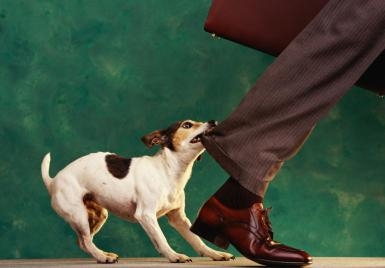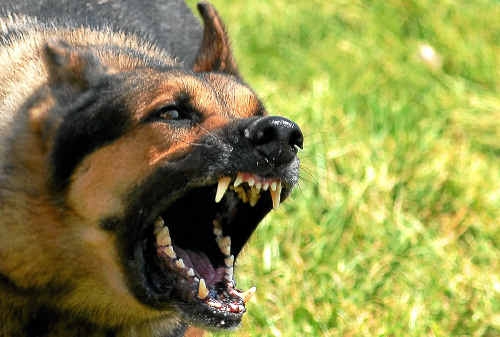
Call us Now ![]() +91-8744012053
+91-8744012053
Mon - Sat ~ 10:00 AM - 6:00 PM
Follow & Like
.png)


Call us Now ![]() +91-8744012053
+91-8744012053
Mon - Sat ~ 10:00 AM - 6:00 PM
Follow & Like
.png)


Is your dog aggressive? To find out, look for certain actions such as excessive low barking and growling which are indicative of Aggression and need correction with the help of an expert dog trainer. Noticing the telltale signs early on is required by the owner. But what are these aggressive behaviors? Let’s help you decipher and understand the matter at hand.
 Image – www.alamedalittledogs.org
Image – www.alamedalittledogs.org
Aggression could stem in an animal due to territorial instincts of guarding one’s private space or in a bid to guard its newborns. Aggression has two connotations- the initial warning signal/s and the eventual attack/bite. Wild animals and aggression as a defense mechanism may complement the former’s chances of survival. However in a domestic/pet animal such behaviors are uncalled for.
Dominant behavior could also be related to hormonal/sexual drive, therefore its best to get the male neutered in case you do not plan to go ahead with the breeding.
Low Barking and Growling
In most cases a bite is preceded by a growl. A dog’s growl is a natural response to an intimidating external stimulus that is a potential threat to it and therefore the canine wants to scare and shoo it away. But in a comfortable and secure setting of your home such a behavior should not be taken lightly. The need to introduce your dog to a professional dog trainer arises. Whereby the dog behaviorist can look into the possible reasons for the unacceptable behavior and reform the pet. A hostile pet usually holds up his ears stiffly upright and may also hold its tail tall.
Is your dog trying to keep its desired belongings such as a toy away from you? Is it resorting to growling when you try to touch/pet it? One possible reason could be fear.

An aggressive dog will show-off its teeth to another canine in anger, make direct eye contact with it or your pet could also growl with its hackles raised. Image Source – www.news-mail.com.au
Sometimes the pet is fearful of another dog or human. At times an injury and the associated pain can instill fear of being touched on that particular area/body part. These are often traits of a defensive-aggressive canine. Such a dog will avoid making an eye contact, it would hold back its ears, and it may slip & position its tail between its legs.

Watch out for signs such as your pet obstructing your passage or that of another dog while on its outdoor stint. On some occasions it will come in between when you try to mingle with another dog. It may not even like you hugging or sitting close to your partner. It will want to be the centre of its owner’s attention. Do not ignore these actions; consider them being a warning signal and start working on solving any such activity.
A Snappy Dog is not an obedient dog
The dog could snap and try to bite you. Many times it will not make a direct contact with you but may come close and gnash its teeth in fury at the air in order to warn before proceeding with any kind of full attack.
Dog to people as well as dog to dog aggression is a matter of concern that needs to be dealt with before your dog causes serious harm to any person or another dog.
Your dog could show-off its teeth to another canine in anger, make direct eye contact with it or your pet could also growl with its hackles raised.
Nipping and Biting
Don’t overlook at instances where the dog grasps and pulls on someone’s clothing. Such situations along with a full bite require serious considerations. The need to hire a professional trainer at this point becomes imperative without further delay.
Steps that will help prevent your dog from becoming aggressive
Firstly it is important not to typecast any particular breed as being aggressive, even small breeds can act aggressively. It is often seen, a dog that lacks the required amount of physical and mental stimulation gets frustrated and this then leads to aggression.
Another precursor of aggression in canines is the lack of an effective, calm and confident pack leader. This sort of leadership should be provided by the dog owner by winning the pet’s confidence, respect and faithfulness. It is important to understand deeply the dog’s instinctual behaviors and offer them a lifestyle that will be in the best interest of the breed. You can only earn the role of a successful pack leader by setting the right kind of do’s & don’ts as well as the required set of restrictions for your dog. The need to dominate takes a back seat in the presence of a good pack leader.
Early socialization really helps to train puppies to behave well. Encourage the puppy to engage in play with other pups and also intermingle with older trained dogs. Always monitor such engagements.
Be respectful and considerate towards your dog. Use the reward-reinforcement technique and employ other positive ways to train your dog. Never be harsh with or punish and intimidate the pet. This will only worsen the aggression problem.
Get help from a dog trainer that will not just work on the dog’s behavioural problems but also help the master understand its dog better and highlight ways to deal with the pet efficiently.
Article Resource:
http://iheartdogs.com
http://sitmeanssit.com